Cluster locates the source of non-thermal terrestrial continuum radiation by triangulation
17 September 2004
Published 14 July 2004, in Annales Geophysicae, a multipoint analysis of Cluster data allows, for the first time, to locate the source of non-thermal terrestrial continuum radiation by triangulation. This study also reveals the importance of small-scale density irregularities in the local amplification of these radiations, which triggers the need of more detailed generation and propagation models.
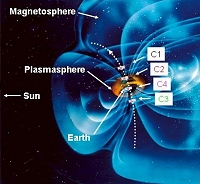 |
|
Image 1: Cluster passing the Earth's plasmasphere |
The term continuum refers to radiation banded in frequency, displaying spectral stability in intensity, over a typical time scale of several hours.
Over the last 30 years, NTC radiation has been observed not only in the Earth environment but also from the magnetosphere of Jupiter, Saturn, Uranus and Neptune; in other words, from all planets of our Solar system with a strong magnetic field.
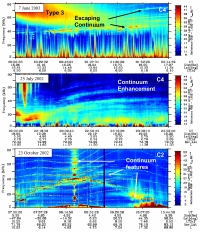 |
|
Image 2: Continuum radiation measured by WHISPER |
NTC results from the mode conversion of electrostatic waves to electromagnetic waves. Even if different theories of mode conversion have been proposed, the generation, the amplification and the propagation of NTC remain open questions. All these questions are linked to the source location(s) of NTC.
On Cluster, NTC is observed in a variety of magnetospheric regions (Image 2). These include: the solar wind, the magnetosheath (top panel), the magnetotail (middle panel) and the inner magnetosphere (bottom panel).
Past observations led to the conclusion that the source of NTC may not be unique but multiple, originating from the plasmapause region, mainly in the equatorial plane. Additionally, according to one of the two main theories of mode conversion (Jones, 1976), the magnetopause may also be a possible source region (Jones, 1987).
Using the unique space fleet configuration of Cluster, the position of NTC sources have been identified, for the first time, by triangulation (see below for more information on triangulation). Each time, NTC was found originating from the plasmapause region (Image 3), but sometimes out of the equatorial plane (Image 4).
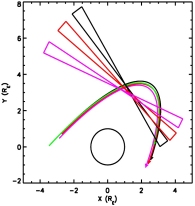 |
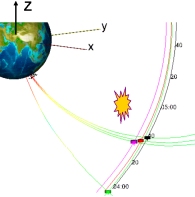 |
|
Image 3: NTC radiation source region in plasmapause region |
Image 4: NTC radiation source region outside equatorial plane |
"The classical view of a source placed both at the plasmapause and at the equator is ruled out", wrote Dr. P. Décréau, PI of the Cluster relaxation sounder (WHISPER**) and lead author on this research, published 14 July 2004 in Annales Geophysicae.
Another interesting finding is the observation of NTC amplification in the presence of local density depletions of small size (Image 5). These observations suggest a possible role of small-scale irregularities on radiation properties of NTC, including propagation path. This finding triggers the need of more refined models.
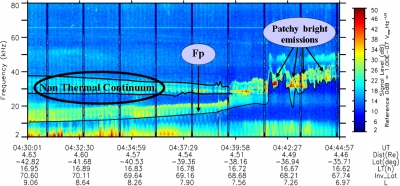 |
|
Image 5: Electric field spectrogram from Cluster C2 showing the amplification of NTC radiation. |
More observational advances on NTC are foreseen in the coming years, thanks to the large spacecraft separations foreseen: "Triangulation at large distance from the source would help to reduce the estimated angular dimension of the source region. Triangulation for instance from the magnetosheath is not yet possible but should be done during the future mission phases (2005 onwards), when large spacecraft separations are foreseen", Décréau added.
Triangulation
Direction finding analysis
The electric field intensity of NTC detected by WHISPER on each Cluster spacecraft shows a pronounced modulation caused by the rotation of the electric antenna. This property is used to determine the direction of propagation, projected into the plane of rotation of the antenna (spin plane).
Locating source regions
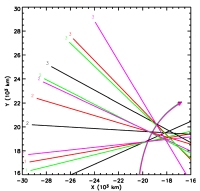 |
|
Image 6: Locating NTC source region by triangulation |
Under the assumption of stability of the location of the source region, directions measured even at a limited precision can lead to a plausible triangulation (Image 6), again to be considered as the projection of the source in a plane.
---
* Plasmapause : the outer boundary layer of the plasmasphere.
** WHISPER : Waves of HIgh frequency and Sounder for Probing of Electron density by Relaxation.
Décréau, P. M. E., C. Ducoin, G. LeRouzic, O. Randriamboarison, J.-L. Rauch, J.-G. Trotignon, X. Vallières, P. Canu, F. Darrouzet, M. P. Gough, A. M. Buckley, T. D. Carozzi, Observation of continuum radiations from the Cluster fleet: first results from direction finding, Annales Geophysicae, 22, 2607-2624, 2004
Related articles
D. Jones, Source of terrestrial non-thermal radiation, Nature, 260, 686, 1976.
D. Jones, The magnetopause as a source of nonthermal continuum radiation, Phys. Scr., 35, 887, 1987.
Contact
Pierrette Décréau, LPCE, CNRS and Université d'Orléans, Orléans, France
Tel +33-2-38-25-52-81
Web story author
Arnaud Masson, SCI-SH division, RSSD, ESA, The Netherlands
Tel: +31-71-565-5634
Web story editor
Philippe Escoubet, SCI-SH division RSSD, ESA, The Netherlands
Tel: +31-71-565-3454

